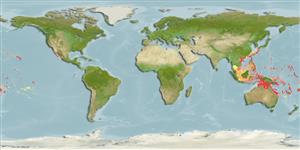Common names from other countries
>
Perciformes/Uranoscopoidei (Sand dwellers) >
Pinguipedidae (Sandperches)
Etymology: Parapercis: Greek, para = the side of + Greek, perke = perch (Ref. 45335); australis: Named for its southern distribution, south of 14° south latitude..
More on author: Randall.
Environment: milieu / climate zone / depth range / distribution range
Ecologia
marinhas demersal; intervalo de profundidade 1 - 82 m (Ref. 86942). Tropical; 1°N - 38°S, 129°E - 172°W
Western Central Pacific: Queensland, Australia (Ref. 54621) and Tonga (Ref. 53797).
Tamanho / Peso / Idade
Maturity: Lm ? range ? - ? cm
Max length : 9.2 cm SL macho/indeterminado; (Ref. 57562)
Descrição breve
Chaves de identificação | Morfologia | Morfometria
Espinhos dorsais (total) : 5; Raios dorsais moles (total) : 20 - 21; Espinhos anais: 1; Raios anais moles: 17. D V,20-21 (rarely 20); A I,17; 14-16 (rarely 14 or 16) pectoral rays; 48-59 lateral-line scales; 3-4 + 6-8 gill rakers; 5-6 predorsal scales; ctenoid scales on cheek; front of lower jaw with 10 canine teeth; vomerine teeth in a broad chevron pattern; with palatine teeth; upper edge of subopercle with a prominent sharp spine; posterior edge of preopercle sometimes slightly irregular or partially finally serrate; body depth 4.35-4.9 in SL (20.5-23.0% SL); middle dorsal spine longest, 9.5-10.6% SL; membrane from last dorsal spine joined to base of first soft ray; slightly rounded caudal fin, 22.9-24.0% SL; color pattern essentially similar to Parapercis cylindrica except that the caudal fin is not yellow (Ref. 57562).
Type specimen collected from a depth of 3 m (Ref. 53797).
Life cycle and mating behavior
Maturities | Reprodução | Spawnings | Egg(s) | Fecundities | Larvas
Randall, J.E., 2003. Review of the sandperches of the Parapercis cylindrica complex (Perciformes: Pinguipedidae), with description of two new species from the western Pacific. Bishop Museum Occasional Papers (72):1-19. (Ref. 57562)
Categoria na Lista Vermelha da IUCN (Ref. 130435)
CITES (Ref. 128078)
Not Evaluated
Ameaça para o homem
Harmless
Utilização humana
Ferramentas
Warning: mysqli::__construct(): (HY000/1040): Too many connections in /var/www/html/includes/speciessummary.lib.php on line 2104
Can't connect to MySQL database fbquizv2. Errorcode: Too many connections
